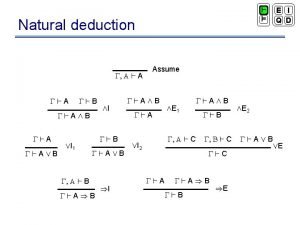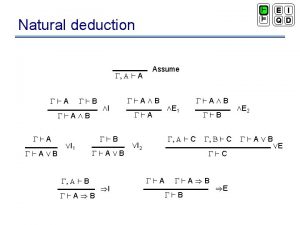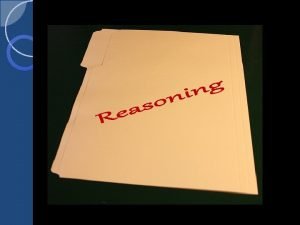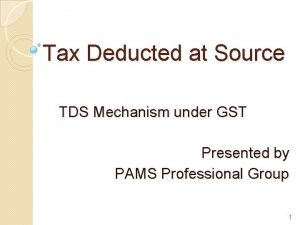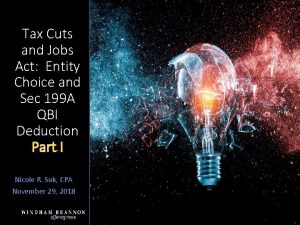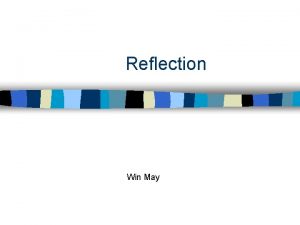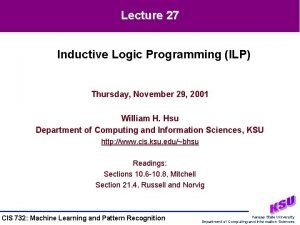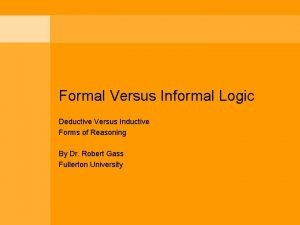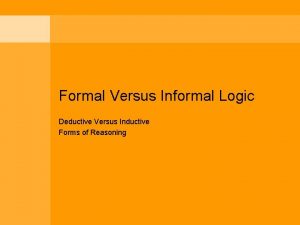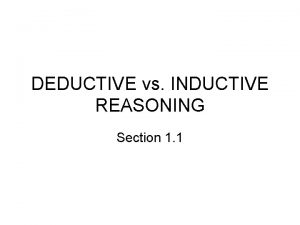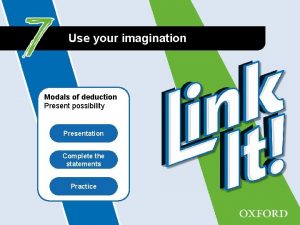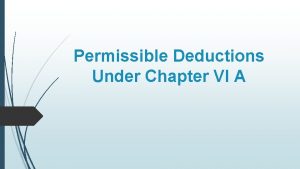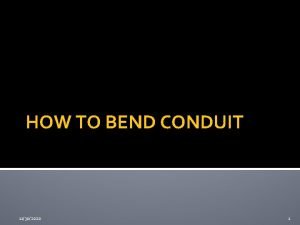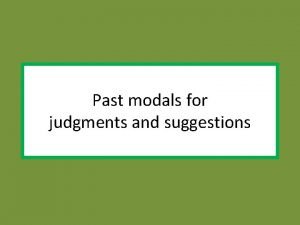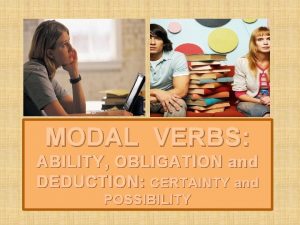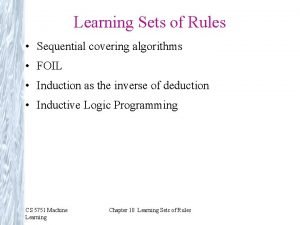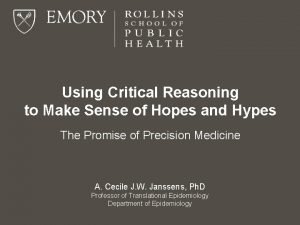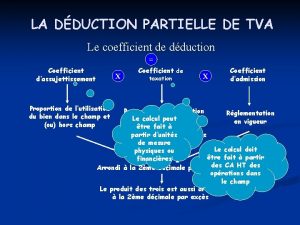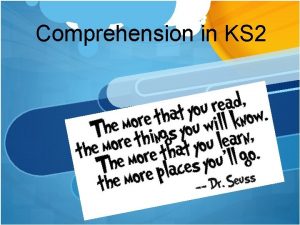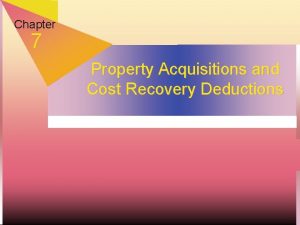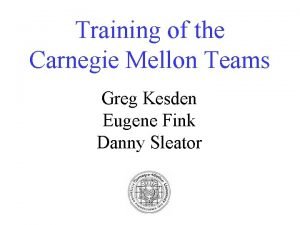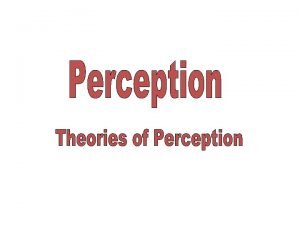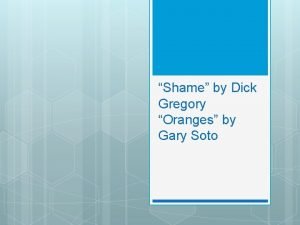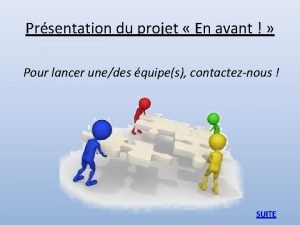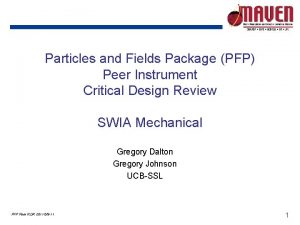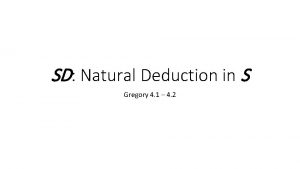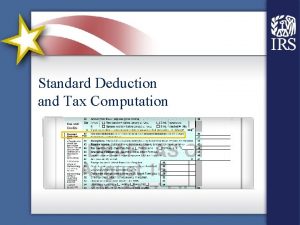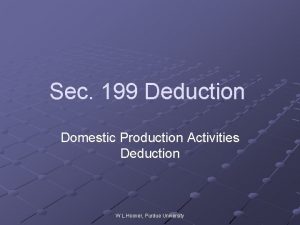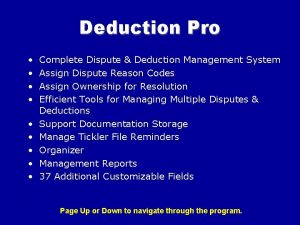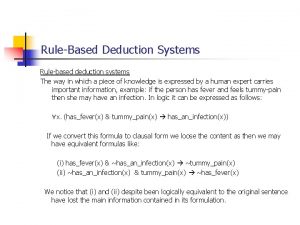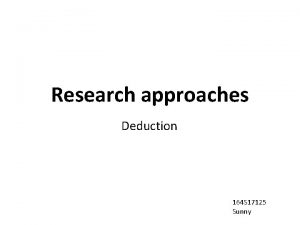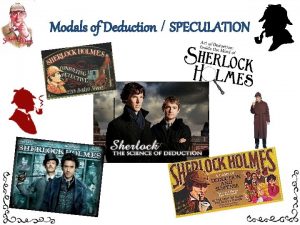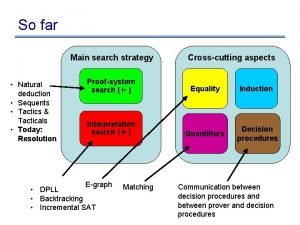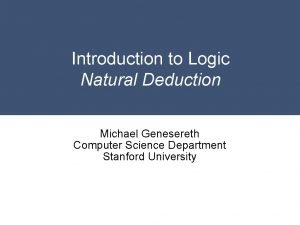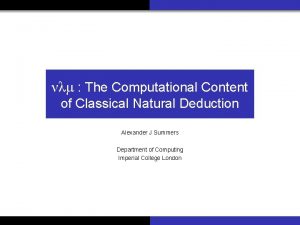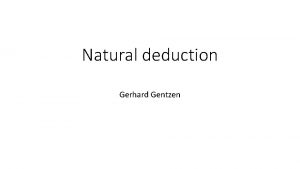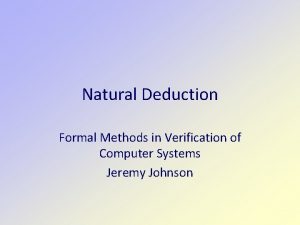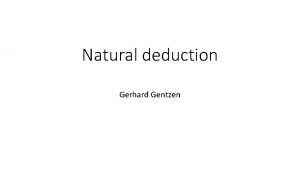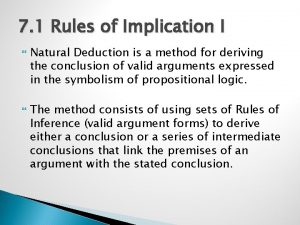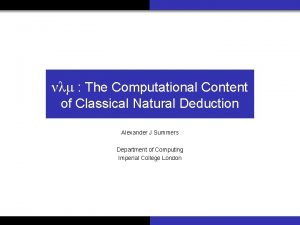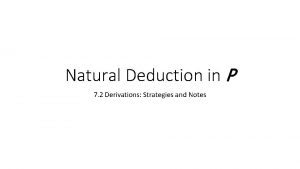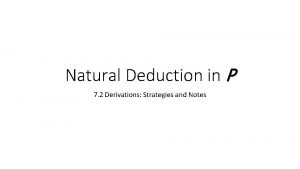SD Natural Deduction in S Gregory Chapter 4





































- Slides: 37

SD: Natural Deduction in S Gregory Chapter 4

Anatomy of a Proof Primary Assumptions Target (conclusion) Scope Line

What is Natural Deduction? • A (very) brief history of logic (cultural enrichment) - Aristotelian Logic and its elaborations - Boole, Peirce, Frege, Principia and beyond: Axiomatic Systems & Natural Deduction • The Rules of Inference - Each of the 5 connectives has an introduction rule and an elimination rule. - The Reiteration Rule allows lines of the proof to be repeated. • The Rules are truth-preserving! • Two concepts of validity: semantic entailment (⊨ ) and derivability (⊢)

How the Rules Work Input Output Justification • Each line a proof is numbered for reference. • The output is the result of applying the Rule R to input line i • To justify writing the output line cite the rule and the number of the line to which it was applied.

4. 1 Connective in and out rules

Wedge Rules - ∧I and ∧E • Note: like all the Rules of Inference they can only be applied to whole lines. • Note: Like all the Rules they can be shown to be truth preserving via truth tables.

∧I: Example • Each of the moves is legal--this shows you what can be done with the rule • But lines 4 and 5 are irrelevant to the proof.

∧E: Example • Note: cant derive 4 directly from 1! • Correct application of a rule matter of syntax and symbolic form!

Arrow Rules - →I and →E • →E mimics modus ponens • →I involves a subderivation, beginning with the auxiliary assumption ℙ marked off by a new scope line and horizontal - The idea is we’re saying ‘what if ℙ … from which we derive ℚ … - So we conclude that if we had ℙ the we’d get ℚ, i. e. ℙ → ℚ

→E: Example • How do we know where to start? We think our way back from the goal until we can start. • We look for the conclusion in the premises • And by successive application of rules get it out

→I: Example • We want to prove a conditional, I → (¬ G ∧ R). • We assume the antecedent, I, writing ‘A’ as justification for the line, indenting and introducing new scope line--to enter the World of What If. • We derive the consequent. • Pop out of the World of What-If, ‘discharging’ the assumption, citing line numbers of subderivation.

Negation Rules - ¬I and ¬E • Reductio ad Absudum rules: compare to truth tree test for validity! • We assume the opposite of what we want to prove and show that it implies a contradiction: a sentence and the negation of that sentence. • Which shows the assumption was bad--and so we can infer the opposite of the assumption.

¬E: Example • We want to prove S • Going into the World of What-If we assume ¬ S • And show that ¬ S is bad since it leads to both ¬ J and J • Since ¬ S is bad, S is good! • So we discharge the sequence, writing S

Vee Rules - ∨I and ∨E • ∨I: You are not getting something for nothing here (I’ll explain) • ∨E: Constructive Dilemma: Either ℙ or ℚ , if ℙ we get ℝ and if ℚ we get ℝ. Gotta be one or the other and either way, we get ℝ

∨I: Example • We need to make the antecedent of 2 to get ¬ K • So add N to S by ∨I • Note: this only works with ∨! The result of applying the rule is not stronger than the sentence to which it was applied!

∨E: Example • We want F • We have either S or N and • The S road and N road both lead to F • So we have F

Double Arrow Rules - ↔I and ↔E • Biconditional is conditional going both ways--equivalent to conjunction of the two conditionals so… • ↔I is like →I twice over and… • ↔E is like →E -- and can be done on either of the conditionals.

↔ I and E: Example

4. 1. 7 Exercises

4. 2 Derivations: Strategies & Notes Strategy game--there is no algorithm for doing proofs

Goal Analysis - Working Backward

Subderivations

Subderivations Example

Proving a Tautology • Remember, a tautology can be derived from the empty set of sentences - Since there’s no TVA on which a tautology is false, in any argument where the conclusion is a tautology, there’s no TVA in which the premises, whatever they are, if any, are true and the conclusion is false. • Proving a tautology is deriving it from the empty set of sentences.

4. 3 Proof Theory in SD

Derivations in SD

Other Properties Theorem of SD: A WFF ℙ is a theorem of SD iff ℙ is derivable from the empty set, i. e. , iff ⊢ ℙ. Equivalent in SD: Two WFFs ℙ and ℚ are equivalent in SD iff they are interderivable in SD, i. e. , iff both ℙ ⊢ ℚ and ℚ ⊢ ℙ. Inconsistent in SD: A set Γ of WFFs is inconsistent in SD iff, for some WFF ℙ, both Γ ⊢ ℙ and Γ ⊢ ¬ ℙ.

4. 3. 1 Exercises

4. 4 SDE, an Extention to SD More rules to make life easier which can be proven from what we already have

4. 4. 1 Additional Inference Rules of SDE

Proving the New Rules

Examples

4. 4. 2 Exercises

4. 4. 3 The Replacement Rules of SD • Replacement rules are bidirectonal--inference rules are not. • Replacement rules apply to both WFFs and well-formed components of WFFs-inference rules apply only to WFFs (whole lines)!

4. 4. 3 The Replacement Rules of SDE

4. 4. 4 Exercises

The Happy Marriage of Semantics & Syntax
 Natural deduction cheat sheet
Natural deduction cheat sheet Natural deduction cheat sheet
Natural deduction cheat sheet Inductive logic definition
Inductive logic definition What is utr in gst
What is utr in gst Gst deduction at source
Gst deduction at source Qbi deduction example
Qbi deduction example Rule based deduction system in artificial intelligence
Rule based deduction system in artificial intelligence Polavaram project
Polavaram project Induction vs deduction
Induction vs deduction Induction as inverted deduction
Induction as inverted deduction Induction v deduction
Induction v deduction Informal deduction
Informal deduction Deductive reasoning examples
Deductive reasoning examples Sound and unsound argument
Sound and unsound argument Modals of deduction present
Modals of deduction present Permissible deduction
Permissible deduction Three bend saddle
Three bend saddle Past modals should have could have
Past modals should have could have Deduction and obligation
Deduction and obligation Foil algorithm
Foil algorithm Deduction
Deduction Argument of definition
Argument of definition Régularisation coefficient déduction tva comptabilisation
Régularisation coefficient déduction tva comptabilisation Definition of inductive argument
Definition of inductive argument Debugging by deduction
Debugging by deduction What is inference and deduction
What is inference and deduction Cost recovery deduction
Cost recovery deduction Natural hazards vs natural disasters
Natural hazards vs natural disasters Natural capital and natural income
Natural capital and natural income Greg kesden cmu
Greg kesden cmu Gregorys constructivist theory
Gregorys constructivist theory Dr gregory stanton
Dr gregory stanton Eight stages of genocide
Eight stages of genocide Process management framework
Process management framework Shame by dick gregory
Shame by dick gregory Gregory delboe
Gregory delboe Greg cairns
Greg cairns Gregory pfp
Gregory pfp
